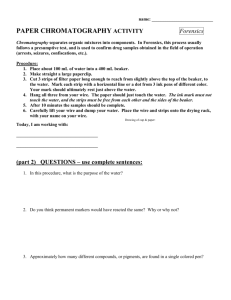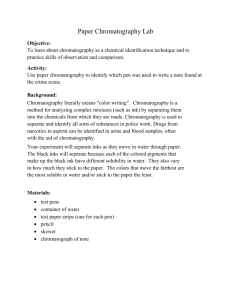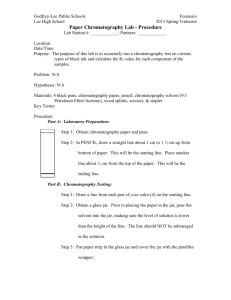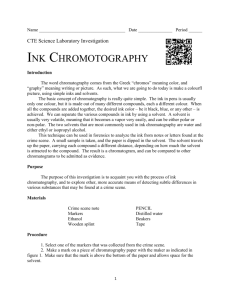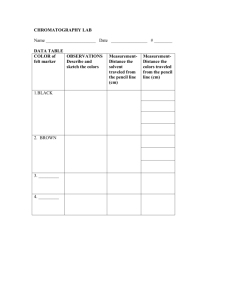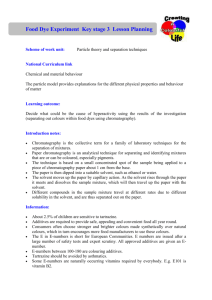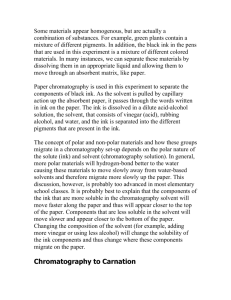FSP 11 Chromatography - The University of Western Australia
advertisement
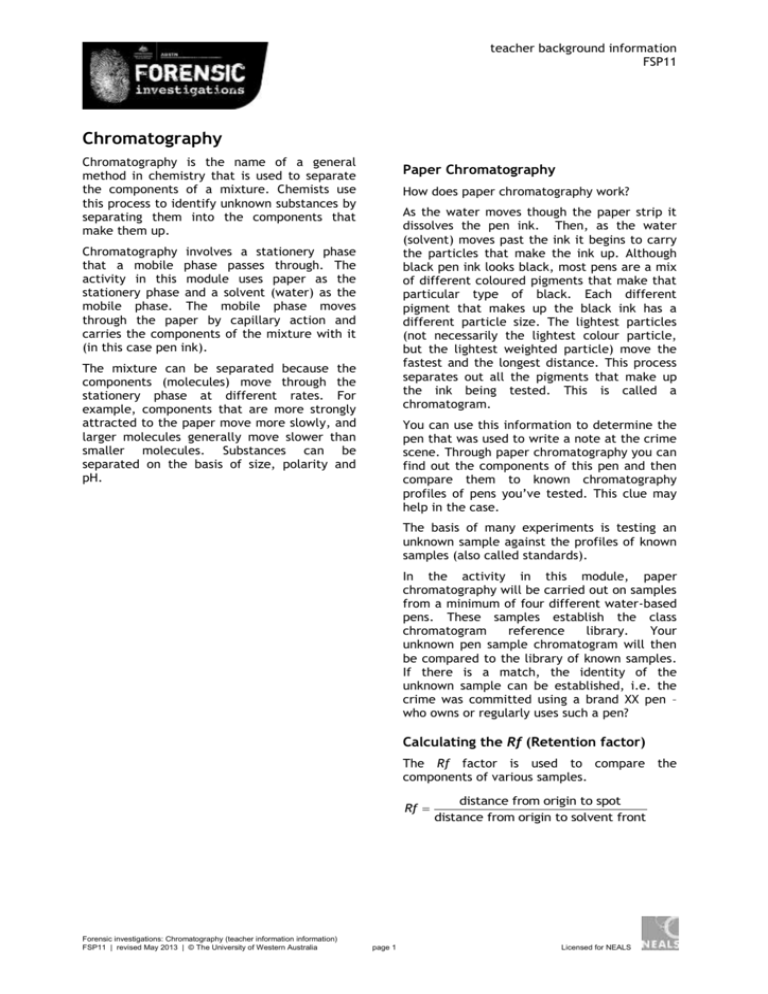
teacher background information FSP11 Chromatography Chromatography is the name of a general method in chemistry that is used to separate the components of a mixture. Chemists use this process to identify unknown substances by separating them into the components that make them up. Paper Chromatography How does paper chromatography work? As the water moves though the paper strip it dissolves the pen ink. Then, as the water (solvent) moves past the ink it begins to carry the particles that make the ink up. Although black pen ink looks black, most pens are a mix of different coloured pigments that make that particular type of black. Each different pigment that makes up the black ink has a different particle size. The lightest particles (not necessarily the lightest colour particle, but the lightest weighted particle) move the fastest and the longest distance. This process separates out all the pigments that make up the ink being tested. This is called a chromatogram. Chromatography involves a stationery phase that a mobile phase passes through. The activity in this module uses paper as the stationery phase and a solvent (water) as the mobile phase. The mobile phase moves through the paper by capillary action and carries the components of the mixture with it (in this case pen ink). The mixture can be separated because the components (molecules) move through the stationery phase at different rates. For example, components that are more strongly attracted to the paper move more slowly, and larger molecules generally move slower than smaller molecules. Substances can be separated on the basis of size, polarity and pH. You can use this information to determine the pen that was used to write a note at the crime scene. Through paper chromatography you can find out the components of this pen and then compare them to known chromatography profiles of pens you’ve tested. This clue may help in the case. The basis of many experiments is testing an unknown sample against the profiles of known samples (also called standards). In the activity in this module, paper chromatography will be carried out on samples from a minimum of four different water-based pens. These samples establish the class chromatogram reference library. Your unknown pen sample chromatogram will then be compared to the library of known samples. If there is a match, the identity of the unknown sample can be established, i.e. the crime was committed using a brand XX pen – who owns or regularly uses such a pen? Calculating the Rf (Retention factor) The Rf factor is used to compare the components of various samples. Rf = Forensic investigations: Chromatography (teacher information information) FSP11 | revised May 2013 | © The University of Western Australia page 1 distance from origin to spot distance from origin to solvent front Licensed for NEALS For example: The Rf for a compound is a constant from one experiment to the next only if the chromatography conditions below are also constant: Solvent (water) Adsorbent material (filter paper) Thickness of the adsorbent (same type of filter paper) Amount of material spotted (use the same amount of ink) Temperature (must also be constant) Since these factors are very difficult to keep constant from experiment to experiment, relative Rf values are generally considered. ‘Relative Rf’ means that the values are reported relative to a standard, or it means that you compare the Rf values of compounds run on the same paper at the same time. Calculations: Rf A = 35/40 = 0.87 Rf B = 20/40 = 0.5 Rf C = 10/40 = 0.25 The Rf can provide corroborative evidence as to the identity of a compound. If the identity of a compound is suspected but not yet proven, an authentic sample of the compound, or standard, is spotted and run side by side with the compound in question. If two substances have the same Rf value, they are likely (but not necessarily) the same compound. If they have different Rf values, they are definitely different compounds. The Rf of each component is an individual characteristic used to compare the components in various samples. In this module’s activity, you simply want to compare the Rf values of the suspect sample with the known standards. NB: Measure the Rf value in the centre of the spot. Forensic investigations: Chromatography (teacher information information) FSP11 | revised May 2013 | © The University of Western Australia page 2


